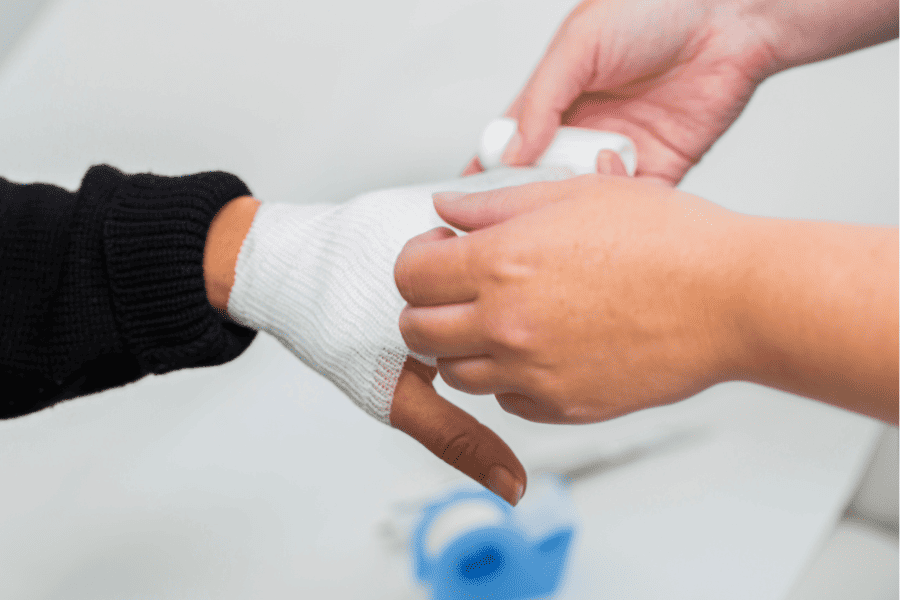 As caregivers, knowing how to care for post-surgical wounds effectively is vital in supporting recovery at home. Understanding the healing process and navigating each stage can significantly impact the outcome.
As caregivers, knowing how to care for post-surgical wounds effectively is vital in supporting recovery at home. Understanding the healing process and navigating each stage can significantly impact the outcome.
Success for post-surgical wound care should result in quick healing, no infection, minimal scarring, and little pain. Your patient should recover quickly with the proper dressing and these tips for managing post-surgical wounds.
Why is Post-Surgical Wound Care Important?
Ensuring proper care for wounds has all kinds of benefits for recovery, especially in post-surgical care.
- Preventing Infections: Proper care reduces the risk of infections that could delay healing or lead to more serious complications.
- Promoting Healing: It supports the body’s natural healing process, aiding in quicker recovery and minimizing scarring.
- Reducing Discomfort: Good wound care practices help manage pain and discomfort, enhancing the patient’s comfort during recovery.
- Minimizing Complications: Keeping the wound clean and monitored reduces the chances of complications, such as excessive bleeding or reopening of the wound.
- Optimizing Recovery Time: Well-managed wound care can shorten overall recovery time, allowing patients to resume regular activities sooner.
- Enhancing Overall Health: A well-healed wound contributes to the patient’s overall health and well-being, preventing potential setbacks in their recovery journey.
What is the Timeline for Post-Surgical Wound Care?
Healing takes time after surgery, but effective wound care can speed up recovery and decrease the risk of infection. Here is a look at what to expect:
- Hemostasis (0-2 days):
Right after surgery, the body initiates hemostasis to stop bleeding. The wound may appear red and swollen initially. - Inflammation (3-5 days):
During this phase, the body’s defense mechanisms kick in, leading to redness, swelling, and warmth around the wound. White blood cells work to fight infection, and the wound might feel tender. - Proliferation (5-21 days):
New tissue forms and the wound begins to close. Granulation tissue develops, filling the wound with collagen and new blood vessels. The wound may start to itch as it heals. - Remodeling (21 days to 2 years):
The wound continues to strengthen as collagen remodels. Scar tissue forms and gradually fades, although it may take up to two years to mature fully.
Tips for Effective Post-Surgical Wound Care:
 You can do a few things to ensure a post-surgical wound stays clean and uninfected.
You can do a few things to ensure a post-surgical wound stays clean and uninfected.
1. Keep it Clean:
- Follow healthcare provider instructions for cleaning the wound.
- Use mild soap and water or a saline solution to clean the wound gently.
2. Change Dressings Regularly:
- Replace dressings as advised by the healthcare provider.
- Ensure the wound area is dry before applying a new dressing.
3. Monitor for Infection:
- Look for signs of infection, such as increased redness, warmth, swelling, or pus.
- Contact the healthcare provider if you notice any unusual changes.
4. Support Healing with Nutrition:
- Provide a balanced diet rich in protein, vitamins, and minerals to aid the healing process.
5. Protect the Wound:
- Encourage the patient to avoid activities that might strain or reopen the wound.
- Ensure the wound is protected from potential sources of contamination.
6. Manage Pain:
- Administer prescribed pain medication as instructed.
- Use ice packs or other approved methods to manage discomfort as recommended.
7. Follow-Up Care:
- Attend scheduled follow-up appointments to monitor the healing progress and address any concerns.
What Signs of Infection to Look For
Detecting signs of infection in a wound is vital. Here are indicators to watch for:
- Increased Redness: Watch for the area around the wound becoming redder or spreading.
- Swelling and Warmth: Notice any persistent swelling or warmth near the wound.
- Pus or Discharge: Check for any unusual discharge, especially if it has an odd color or odor.
- Fever or Chills: Pay attention to the sudden onset of fever or chills without explanation.
- Increased Pain: Note if the pain around the wound intensifies instead of easing.
- Delayed Healing: If the wound doesn’t seem healing or reopens, seek medical advice promptly.
By understanding the phases of wound healing and implementing these post-surgical care tips, caregivers can play a pivotal role in ensuring a successful recovery for their loved ones. Each individual’s healing journey is unique, so always consult healthcare professionals for personalized guidance throughout recovery.
Our Doctors Come To You
At Freedom Health and Wellness, our commitment to supporting patients extends beyond the clinical setting. Contact us for personalized advice and assistance tailored to your loved one’s needs in the comfort of their home. Together, let’s ensure a comfortable and successful recovery journey.

